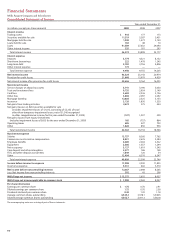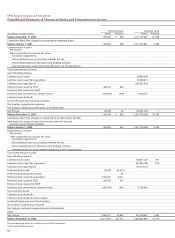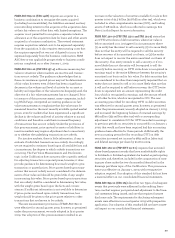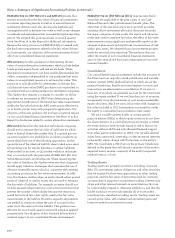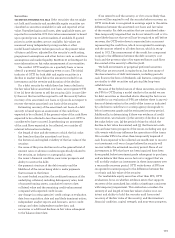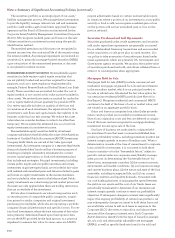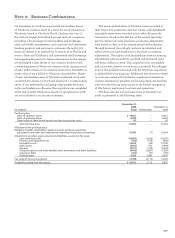Wells Fargo 2009 Annual Report Download - page 102
Download and view the complete annual report
Please find page 102 of the 2009 Wells Fargo annual report below. You can navigate through the pages in the report by either clicking on the pages listed below, or by using the keyword search tool below to find specific information within the annual report.
Note 1: Summary of Significant Accounting Policies (continued)
FASB ASC 825-10 (FSP FAS 107-1 and APB 28-1) states that
entities must disclose the fair value of financial instruments
in interim reporting periods as well as in annual financial
statements. Entities must also disclose the methods and
assumptions used to estimate fair value as well as any changes
in methods and assumptions that occurred during the reporting
period. We adopted this pronouncement in second quarter
2009. See Note 16 in this Report for additional information.
Because the new provisions in FASB ASC 825-10 amend only
the disclosure requirements related to the fair value of finan-
cial instruments, our adoption of this pronouncement did not
affect our consolidated financial statements.
ASU 2009-12 provides guidance for determining the fair
value of certain alternative investments, which include hedge
funds, private equity funds, and real estate funds. When
alternative investments do not have readily determinable fair
values, companies are permitted to use unadjusted net asset
values or an equivalent measure to estimate fair value. This
provision is only allowable for investments in entities that
calculate net asset value (NAV) per share or its equivalent in
accordance with accounting guidance for investment companies.
This Update also requires a company to consider its ability
to redeem an investment at NAV when determining the
appropriate classification of the related fair value measurement
within the fair value hierarchy. ASU 2009-12 was effective for
us in fourth quarter 2009 with prospective application. Our
adoption of this new guidance did not have a material impact
on our consolidated financial statements. See Note 16 in this
Report for disclosures related to certain alternative investments.
ASU 2009-5 describes the valuation techniques companies
should use to measure the fair value of liabilities for which
there is limited observable market data. If a quoted price in
an active market is not available for an identical liability, an
entity should use one of the following approaches: (1) the
quoted price of the identical liability when traded as an asset,
(2) quoted prices for similar liabilities or similar liabilities
when traded as an asset, or (3) another valuation technique
that is consistent with the principles of FASB ASC 820, Fair
Value Measurements and Disclosures. When measuring the
fair value of liabilities, this Update reiterates that companies
should apply valuation techniques that maximize the use of
relevant observable inputs, which is consistent with existing
accounting provisions for fair value measurement. In addi-
tion, this Update clarifies when an entity should adjust quoted
prices of identical or similar assets that are used to estimate
the fair value of liabilities. For example, an entity should not
include separate adjustments for contractual restrictions that
prevent the transfer of the liability because the restriction
would be factored into other inputs used in the fair value
measurement of the liability. However, separate adjustments
are needed in situations where the unit of account for the
asset is not the same as for the liability. This guidance was
effective for us in fourth quarter 2009 with adoption applied
prospectively. Our adoption of this standard did not have a
material impact on our consolidated financial statements.
FASB ASC 715-20 (FSP FAS 132 (R)-1) requires new disclo-
sures that are applicable to the plan assets of our Cash
Balance Plan and other postretirement benefit plans. The
objectives of the new disclosures are to provide an under-
standing of how investment allocation decisions are made,
the major categories of plan assets, the inputs and valuation
techniques used to measure fair value, the effect of fair value
measurements using significant unobservable inputs on the
changes in plan assets and significant concentrations of risk
within plan assets. We adopted this pronouncement prospec-
tively for year-end 2009 reporting. The guidance does not
affect the results of our consolidated financial statements
since it only amends the disclosure requirements for postre-
tirement benefits.
Consolidation
Our consolidated financial statements include the accounts of
the Parent and our majority-owned subsidiaries and variable
interest entities (VIEs) (defined below) in which we are the
primary beneficiary. Significant intercompany accounts and
transactions are eliminated in consolidation. If we own at
least 20% of an entity, we generally account for the investment
using the equity method. If we own less than 20% of an entity,
we generally carry the investment at cost, except marketable
equity securities, which we carry at fair value with changes in
fair value included in OCI. Investments accounted for under
the equity or cost method are included in other assets.
We are a variable interest holder in certain special-
purpose entities (SPEs) in which equity investors do not have
the characteristics of a controlling financial interest or where
the entity does not have enough equity at risk to finance its
activities without additional subordinated financial support
from other parties (referred to as VIEs). Our variable interest
arises from contractual, ownership or other monetary interests
in the entity, which change with fluctuations in the entity’s
NAV. We consolidate a VIE if we are the primary beneficiary,
defined as the entity that will absorb a majority of the entity’s
expected losses, receive a majority of the entity’s expected
residual returns, or both.
Trading Assets
Trading assets are primarily securities, including corporate
debt, U.S. government agency obligations and other securities
that we acquire for short-term appreciation or other trading
purposes, and the fair value of derivatives held for customer
accommodation purposes or proprietary trading. Interest-only
strips and other retained interests in securitizations that can
be contractually prepaid or otherwise settled in a way that the
holder would not recover substantially all of its recorded
investment are classified as trading assets. Trading assets are
carried at fair value, with realized and unrealized gains and
losses recorded in noninterest income.


